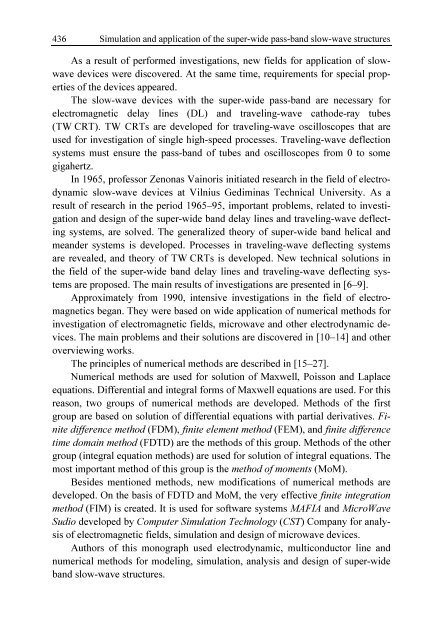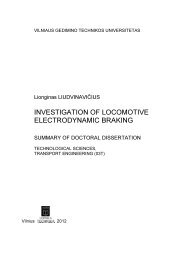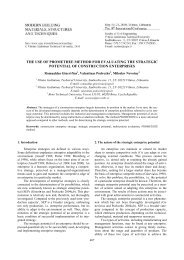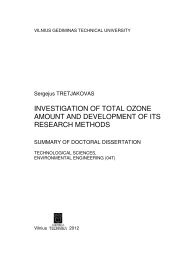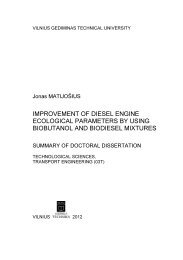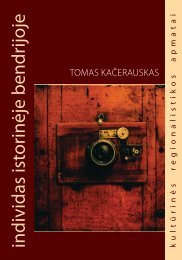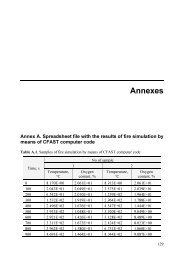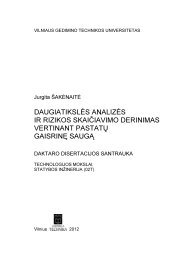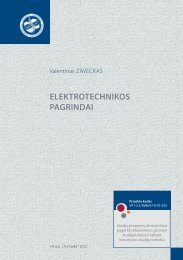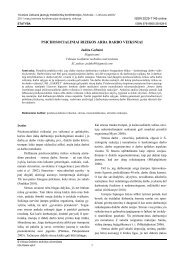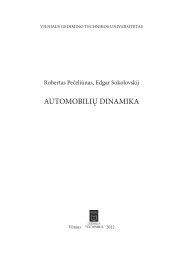- Page 1 and 2:
Stanislovas Štaras, Romanas Martav
- Page 3 and 4:
UDK 621.37Pl-08S. Štaras, R. Marta
- Page 6 and 7:
TurinysŽymenys 11Įvadas 151. NEVI
- Page 8:
3.4. Integralinių lygčių metodo
- Page 11 and 12:
108.4. Meandrinių lėtinimo sistem
- Page 13 and 14:
12 ŽymenysK perdavimo funkcija, K
- Page 16 and 17:
Įvadas1864 metais D. K. Maksvelas
- Page 18 and 19:
elektromagnetinių laukų ir elektr
- Page 20 and 21:
specifinius klausimus, atkreipiamas
- Page 22 and 23:
[0.5] Тараненко, З. И.;
- Page 24 and 25:
1.Nevienalyčių spiralinių sistem
- Page 26 and 27:
25C11+C12C1= , (1.2)2L11+L12L1= , (
- Page 28 and 29:
271.2 pav. Lėtinimo koeficiento pr
- Page 30 and 31:
291.4 pav. Ašinės simetrijos spir
- Page 32 and 33:
čia k 0 = ω/c0.kω2π f k31Lxx =
- Page 34 and 35:
33ab1.7 pav. Ašinės simetrijos sp
- Page 36 and 37:
351.9 pav. Ašinės simetrijos spir
- Page 38 and 39:
37Acoshkdi ii = ki,coshkidi⋅ sinh
- Page 40 and 41:
39ab1.12 pav. Asimetriškai išorin
- Page 42 and 43:
ZB=⎛⎜ε2hk1⎝r1tanh k1btanh k
- Page 44 and 45:
431.14 pav. Spiralinių sistemų, a
- Page 46:
Parodyta, kad pasiūlytus modelius
- Page 49 and 50:
482. Daugialaidžių linijų metoda
- Page 51 and 52:
502. Daugialaidžių linijų metoda
- Page 53 and 54:
522. Daugialaidžių linijų metoda
- Page 55 and 56:
542. Daugialaidžių linijų metoda
- Page 57 and 58:
562. Daugialaidžių linijų metoda
- Page 59 and 60:
582. Daugialaidžių linijų metoda
- Page 61 and 62:
602. Daugialaidžių linijų metoda
- Page 63 and 64:
622. Daugialaidžių linijų metoda
- Page 65 and 66:
642. Daugialaidžių linijų metoda
- Page 67 and 68:
662. Daugialaidžių linijų metoda
- Page 69 and 70:
682. Daugialaidžių linijų metoda
- Page 71 and 72:
702. Daugialaidžių linijų metoda
- Page 73 and 74:
722. Daugialaidžių linijų metoda
- Page 75 and 76:
742. Daugialaidžių linijų metoda
- Page 77 and 78:
762. Daugialaidžių linijų metoda
- Page 79 and 80:
782. Daugialaidžių linijų metoda
- Page 81 and 82:
802. Daugialaidžių linijų metoda
- Page 83 and 84:
822. Daugialaidžių linijų metoda
- Page 85 and 86:
842. Daugialaidžių linijų metoda
- Page 87 and 88:
862. Daugialaidžių linijų metoda
- Page 89 and 90:
882. Daugialaidžių linijų metoda
- Page 91 and 92:
902. Daugialaidžių linijų metoda
- Page 93 and 94:
922. Daugialaidžių linijų metoda
- Page 95 and 96:
94CDLSLS( 1 )( 1 )LS LS LS LS11 22
- Page 97 and 98:
962. Daugialaidžių linijų metoda
- Page 99 and 100:
982. Daugialaidžių linijų metoda
- Page 101 and 102:
1002. Daugialaidžių linijų metod
- Page 103 and 104:
1022. Daugialaidžių linijų metod
- Page 105 and 106:
1042. Daugialaidžių linijų metod
- Page 107 and 108:
1062. Daugialaidžių linijų metod
- Page 109 and 110:
1082. Daugialaidžių linijų metod
- Page 112 and 113:
3.Daugialaidžių linijų banginių
- Page 114 and 115:
tolygus dekartinis tinklelis, kurio
- Page 116 and 117:
1153.3 pav. Tinklelio fragmentas di
- Page 118 and 119:
Tai, kad (3.30) išraiška teisinga
- Page 120 and 121:
119Esama ir kitų skaičiavimo algo
- Page 122 and 123:
121Kaip pradiniai duomenys, į prog
- Page 124 and 125:
1233.13 pav. Linijos skersinis pjū
- Page 126 and 127:
125Pastarajai lygčiai galima sutei
- Page 128 and 129:
127Pagal 3.15 pav. nesujungtų trik
- Page 130 and 131:
129Dvimačiams uždaviniams spręst
- Page 132 and 133:
Pažymėtina, kad į Femlab galima
- Page 134 and 135:
133⎛ α1⎞⎜ ⎟α n = α2, (3.
- Page 136 and 137:
N2 2( )i i n i n i i2πε0 n=11351
- Page 138 and 139:
137Nagrinėjant 3.20 pav. atvaizduo
- Page 140 and 141:
139Iš skaitmeninių metodų aptari
- Page 142 and 143:
Kaa D= ,DKpp141D= . (3.108)DTies di
- Page 144 and 145:
143Taigi krūvių dalinių atvaizd
- Page 146 and 147:
1453.25 pav. Mikrojuostelinės lini
- Page 148 and 149:
147Nežinomų krūvių q matrica ap
- Page 150 and 151:
1493.26 pav. Normuotasis krūvio pa
- Page 152 and 153:
151a aaSavosios C 11, C 22 , C 11,C
- Page 154 and 155:
1533.29 pav. Dviejų susietųjų li
- Page 156 and 157:
155elektrinio lauko stipris ore tar
- Page 158 and 159:
157t. y. į laidininkus siunčiant
- Page 160 and 161:
1593.34 pav. Krūvio tankio pasiski
- Page 162 and 163:
1613.37 pav. 12-os laidininkų mikr
- Page 164 and 165:
163siais atvejais kraštinių ir vi
- Page 166:
165[3.36.] TACONIC: Advanced Dielec
- Page 169 and 170:
168 4. Lėtinimo sistemų modeliai
- Page 171 and 172:
170 4. Lėtinimo sistemų modeliai
- Page 173 and 174:
172 4. Lėtinimo sistemų modeliai
- Page 175 and 176:
174 4. Lėtinimo sistemų modeliai
- Page 177 and 178:
176 4. Lėtinimo sistemų modeliai
- Page 179 and 180:
178 4. Lėtinimo sistemų modeliai
- Page 181 and 182:
180 4. Lėtinimo sistemų modeliai
- Page 183 and 184:
182 4. Lėtinimo sistemų modeliai
- Page 185 and 186:
184 4. Lėtinimo sistemų modeliai
- Page 187 and 188:
186 4. Lėtinimo sistemų modeliai
- Page 189 and 190:
188 4. Lėtinimo sistemų modeliai
- Page 191 and 192:
190 4. Lėtinimo sistemų modeliai
- Page 193 and 194:
192 4. Lėtinimo sistemų modeliai
- Page 195 and 196:
194 4. Lėtinimo sistemų modeliai
- Page 197 and 198:
196 4. Lėtinimo sistemų modeliai
- Page 199 and 200:
198 4. Lėtinimo sistemų modeliai
- Page 201 and 202:
200 4. Lėtinimo sistemų modeliai
- Page 203 and 204:
202 4. Lėtinimo sistemų modeliai
- Page 205 and 206:
204 4. Lėtinimo sistemų modeliai
- Page 207 and 208:
206 4. Lėtinimo sistemų modeliai
- Page 209 and 210:
208 4. Lėtinimo sistemų modeliai
- Page 211 and 212:
210 4. Lėtinimo sistemų modeliai
- Page 214 and 215:
5.Plačiajuosčių lėtinimo sistem
- Page 216 and 217:
215Voltaire LS ir Voltaire XL leid
- Page 218 and 219:
5.1.1. Spiralinės lėtinimo sistem
- Page 220 and 221:
2195.6 pav. Spiralinės lėtinimo s
- Page 222 and 223:
221Šiuo būdu apskaičiuota vėlin
- Page 224 and 225:
2235.11 pav. Spiralinės sistemos l
- Page 226 and 227:
2255.13 pav. Dvipradės spiralių s
- Page 228 and 229:
227Z o , o esant sinfaziniam sužad
- Page 230 and 231:
229Tyrimai parodė, kad spiralių s
- Page 232 and 233:
2315.21 pav. Spiralinės sistemos m
- Page 234 and 235:
( h + b)2331 c0fr ≈ ⋅ . (5.9)4
- Page 236 and 237:
235didesnė sistemos banginė varž
- Page 238 and 239:
2375.28 pav. Spiralinės lėtinimo
- Page 240 and 241:
5.4.3. Rezonansinių reiškinių pa
- Page 242 and 243:
2415.33 pav. Perdavimo koeficiento
- Page 244 and 245:
243Vienas iš didžiausių šio pak
- Page 246 and 247:
5.5.2. Vidinių anizotropinių ekra
- Page 248 and 249:
2475.40 pav. Fazės vėlinimo trukm
- Page 250 and 251:
249tarp gretimų spiralės vijų tv
- Page 252 and 253:
2515.46 pav. Nesimetrinės meandrin
- Page 254 and 255:
253ilgis 9 cm, gausime, kad krašti
- Page 256 and 257:
2555.52 pav. Ašinės simetrijos me
- Page 258 and 259:
2575.56 pav. Meandrinių lėtinimo
- Page 260 and 261:
[5.4] Daškevičius, V.; Skudutis,
- Page 262 and 263:
6.Kompleksinis lėtinimo sistemųty
- Page 264 and 265:
263U 0) = (0) , (6.3)0( U1I0( 0) =
- Page 266 and 267:
265čiakampės) ir taip pat tarp ki
- Page 268 and 269:
26777 7 6.77 pav. Meandrinės lėti
- Page 270 and 271:
269U c)= U ( ) , (6.18)I30( 31c30(
- Page 272 and 273:
2716.12 pav. Meandrinių sistemų l
- Page 274 and 275:
2736.14 pav. H profilio meandrinės
- Page 276 and 277:
UI1n ( 2( n+1 ) h275h)= U ( ) , (6.
- Page 278 and 279:
6.3.2. Tyrimas programų paketu Mic
- Page 280 and 281:
6.4. Ašinės simetrijos spiralinė
- Page 282 and 283:
281Įrašius įtampų (6.33) ir sro
- Page 284 and 285:
2836.25 pav. Ašinės simetrijos sp
- Page 286 and 287:
285sistemos dažninės amplitudės
- Page 288 and 289:
7.Lėtinimo sistemų taikymaselektr
- Page 290 and 291:
2897.1 pav. Struktūrinė signalini
- Page 292 and 293:
291suderinti, esant aukštesniems d
- Page 294 and 295:
7.2.1. Analitiniai kreipiančiojo e
- Page 296 and 297:
295Siekiant mažinti sistemos bangi
- Page 298 and 299:
2973. Pagal (7.25) apskaičiuojame
- Page 300 and 301:
2997.9 pav. K E priklausomybės nuo
- Page 302 and 303:
301jθ jpotencialai yra e , -1 ir e
- Page 304 and 305:
303ab7.15 pav. Skersinės elektrini
- Page 306 and 307:
305Pagal 7.16 pav., a sistemoje, su
- Page 308 and 309:
7.3.1. Harmoninių virpesių formos
- Page 310 and 311:
3097.19 pav. Maksimalaus elektronų
- Page 312 and 313:
311kylančius didėjant dažniui, p
- Page 314 and 315:
3137.24 pav. Nesimetrinės lėtinim
- Page 316 and 317:
315bolinę pradinę trajektoriją),
- Page 318 and 319:
7.4. Kreipimo sistemų jungių mode
- Page 320 and 321:
319a b c7.28 pav. Linijų atkarpų,
- Page 322 and 323:
321ab7.30 pav. Signalinio trakto mo
- Page 324 and 325:
7.31 pav. Dažninės amplitudės ch
- Page 326 and 327:
K− jx1 e325sin x= , (7.65)xčia x
- Page 328 and 329:
327iškraipymų, kylančių dėl el
- Page 330 and 331:
3297.35 pav. atvaizduotos kreipimo
- Page 332 and 333:
3317.36 pav. Signalinio trakto (1 k
- Page 334 and 335:
333Dar kartą pažymėtina, kad ele
- Page 336 and 337:
3357.2 lentelė. Įvairių veiksni
- Page 338 and 339:
[7.3] Шкунов, В. А. 1976.
- Page 340 and 341:
8.Lėtinimo sistemų taikymasvėlin
- Page 342 and 343:
3418.1 pav. Meandrinės mikrojuoste
- Page 344 and 345:
Φ( x y z) ( A kx B kx) Φ ( y)∞
- Page 346 and 347:
345ir analizinių metodų rezultat
- Page 348 and 349:
3478.6 pav. Ekvipotencialių linij
- Page 350 and 351:
Lentelėje349C M( i, j)DL1yra pažy
- Page 352 and 353:
351kartojimo periodas D= L1+ L2. Ga
- Page 354 and 355:
353meandro lėtinimo koeficiento kL
- Page 356 and 357:
3558.12 pav. Juostelių išdėstymo
- Page 358 and 359:
357vėlinimo linijos, esant įvairi
- Page 360 and 361:
359yra santykinis dispersijos suma
- Page 362 and 363:
361juostelių pločio sumažėjimo
- Page 364 and 365:
3638.19 pav. Mikrojuostelinės ir d
- Page 366 and 367:
3658.21 pav. Mikrojuostelinės ir d
- Page 368 and 369:
3678.22 pav. Dviekranės meandrinė
- Page 370 and 371:
369meandro viduriu lėtinimo sistem
- Page 372 and 373:
meandrinių lėtinimo sistemų bang
- Page 374 and 375:
373abc8.25 pav. Meandrinėms lėtin
- Page 376 and 377:
šiose srityse išreiškiamos ketur
- Page 378 and 379:
377Paprasčiausios meandrinės lėt
- Page 380 and 381:
379cosRc( kθc A )⎛ A⎞ sin ⎛
- Page 382 and 383:
8.4.3. Paprasčiausių meandrinių
- Page 384 and 385:
22 0α0− 1 0 + 1 2 0383A = B = A
- Page 386 and 387: 385abc8.30 pav. Mikrojuostelinių m
- Page 388 and 389: 387abc8.31 pav. Mikrojuostelinių m
- Page 390 and 391: 389įtampos U (1) ( x ) ir srovės
- Page 392 and 393: (1) (1)( kθcAE) sin ( kθcAE)( ) s
- Page 394 and 395: ( + 1 ) − cos( θ )( + ) ( π ) s
- Page 396 and 397: 3958.34 pav. Mikrojuostelinių mean
- Page 398 and 399: 397Taigi, žinant vėlinimo linijos
- Page 400 and 401: 399pločiui w 2 , yra juostelių il
- Page 402 and 403: lėtinimo koeficiento kL ŽDir įė
- Page 404 and 405: 4038.40 pav. atvaizduotų daugialai
- Page 406 and 407: 405Atskleista, kad, įtaisius mikro
- Page 408 and 409: 407vidutinių bei aukštųjų dažn
- Page 410 and 411: [8.25] Martavičius, R.; Urbanavič
- Page 412 and 413: 9.Elektrodinaminių vėlinimolinij
- Page 414 and 415: 413reikiamus išėjimo parametrus,
- Page 416 and 417: 415Taigi, automatizuoto projektavim
- Page 418 and 419: 417nėms charakteristikoms: skaiči
- Page 420 and 421: 419δtvt −tv ŽD vnom= ≤ δtmin
- Page 422 and 423: 421pagrįsti ankstesniuose šios mo
- Page 424 and 425: 423Šio proceso metu kitų parametr
- Page 426 and 427: 425užuot keitus meandro matmenis 2
- Page 428 and 429: 427sistemos vėlinimo trukmės žem
- Page 430 and 431: 9.5. Spiralinių vėlinimo linijų
- Page 432 and 433: 431Spiralinės linijos su daugeliu
- Page 434 and 435: 433ciklais: vienu atveju keičiamas
- Page 438 and 439: Summary 437In general case, the mai
- Page 440 and 441: Summary 439Studio system is used fo
- Page 442 and 443: Summary 441[22] Itoh, T.; Pelosi, G


